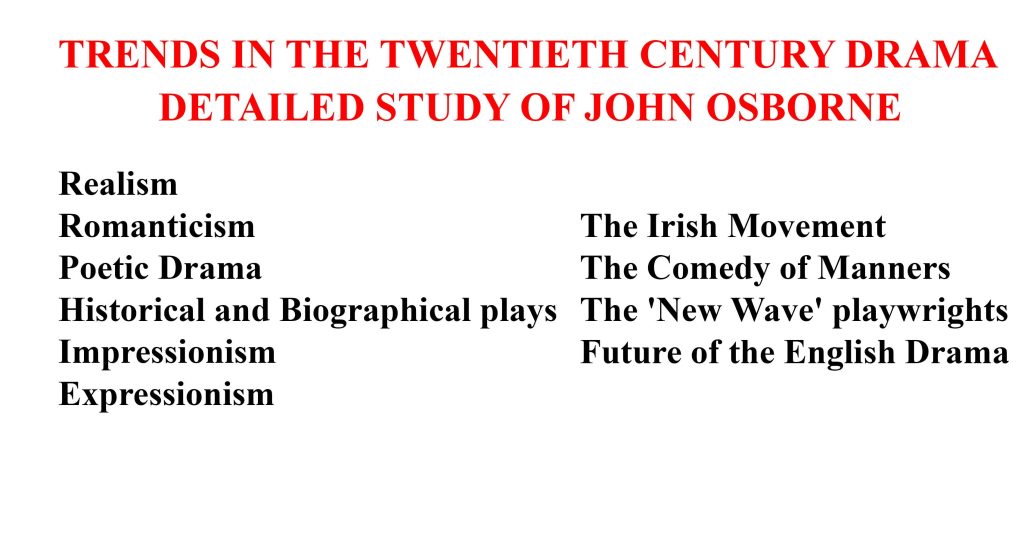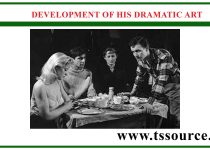TRENDS IN THE TWENTIETH CENTURY DRAMA
DETAILED STUDY OF JOHN OSBORNE

Realism
The literature of the twentieth century was marked by exclusive realism-almost naturalism and drama too was no exception. The early twentieth century drama under the influence of Ibsen, Shaw, Galsworthy was too realistic and too involved with the contemporary social problems. It was Henrik Ibsen, the Norwegian dramatist who popularised the theme of realism in modern drama. He dealt with the problems of life in a realistic way and offered solutions to the vexed problems that confronted the society of his time. In England also realism gained popularity with the works of Robertson, Jones, Pinero, Shaw, Granville- Barkar, Galsworthy and a number of other dramatists who dealt with real life and problems that the modern society faced in their plays. These dramatists have presented real life with all its warts and sordid ugliness. Problems of marriage, justice, law, administration and strife between capital and labourall these problems are dealt in the works of these playwright. Shaw produced his first play with a view to carry the serious drama over into the field of social, domestic or personal problems. A period so keenly aware of social problems was an admirable breeding ground for the drama of ideas. The modern drama dealing with problems of life has become far more intellectual than ever before with the treatment of actual life, the drama became more of ideas, sometimes veiled in the main action and sometimes didactically set forth. The problem plays essentially became the drama of disillusion and squalor slipping off the false glitter of the superficial life. The problem play- wright exposed cant and hypocrisy of the modern times. They were not satisfied in presenting the phenomenon of life and character, they de- sired to reveal the horrid realities behind the sacred ideals and roman- tic common places cherished and upheld by the middle class society.
Romanticism
Romanticism as a trend in Modern drama had given the preponderating trend of realism and propaganda in Modern drama, a jolt which became perceptible with the passage of time. The first new trend against realism in drama was romanticism introduced by the Scottish drama tist J.M. Barrie. His romantic plays Mary Rose, Peter Pan, A Kiss for Cinderella, Admirable Crichton, ton, The Will and Dear Brutus appear somewhat refreshing after the problem and propaganda plays of Pinero Jones, Shaw, Galsworthy and Granville-Barker. The emotions, whims, and sentimentalism implicit in the Scottish Kailyard tradition was exploited by Barrie with determination and professional assurance.
Poetic Drama
Alongwith the development of the naturalistic prose drama or the drama of ideas, the revival of poetic drama also took place. In the beginning of the twentieth century despite the efforts of the major Victorian poets, there was no tradition of poetic drama. By 1920 there were signs of a rebirth, but the atmosphere in which realistic, naturalistic drama throve was uncongenial to poetic drama. At the Abbey theatre Yeats attempted to revive poetry on the stage but lacked the essential qualities of the dramatist. W.B. Yeats and T.S. Eliot defended poetic plays and waged a war against realistic prose drama of the modern age. He is of the opinion that poetry is the natural and complete medium for drama and that prose play is nothing but a kind of abstraction capable of giving one only a part of what the theatre can give; and that verse play is capable of something much more intense and exciting, In Poetry and Drama, Eliot emphasised the ability of poetic drama to capture the exclusive life, comparing it to the vision out of the corner of the eye. Stephen Philips, J.E. Flecker, John Drinkwater, John Masefield, W. B. Yeats, Gordon Bottomely, T.S. Eliot, Christopher Fry are the noteworthy dramatists who gave momentum to the trend of poetic drama in the mod ern age.
Historical and Biographical plays
Another trend that is perceptible in modern drama is in the direction of using history and biography as the material for dramatic treatment. G.B. Shaw was one who popularised historical plays in the modern times. His Caesar and Cleopetra and St. Joan paved the way for other playwrights to follow this trend. Ervine wrote The lady of Belmont, and reproduced many of the old historical characters of Shakespeare. John Drinkwater produced four historical plays-Abraham Lincoln (1918), Mary Stuart (1921-22), Robert Lee (1923) and Oliver Gromwell (1922). In each of these historical plays there is a central character who dominates over the multiplicity of individually delineated character. The plays of Drinkwater are not merely chronic focussing attention on events and external happenings, but plays of ideas, preventing problems of human life in a dramatic form. Clifford Bax also wrote several historical plays. Mr Pepys (1926), Socrates (1930), The Venetican (1931), The Immortal Lady (1931) and The Rose Without a Thorn (1932) are some of his important plays. Ashley Duke’s The Man with a Load of Mischief is a historical play in the sense.not because it includes historical figures as its chief characters but because the word “historical” includes costume plays.
Biography has been used for dramatic purpose in two plays. In Bavcets of Winpole Sheet by Rudolf Besier the love affair of Robert Browning and Elizabeth Barret Browning has been depicted. Reginald Berkly’s The Lady with the Lamp deals with the life-story of Florence Nightingale from her youth to her glorious old age.
Impressionism
Impressionism and expressionism are two trends that are equally well-inarked in modern drama. Impressionism was a movement in painting, music and literature whose aim was to force the beholder, listener or the reader to participate in recreating the experience of the artist and whose method was to suggest “impression” or effect on the artist than to make precise and explicit the objective characteristics of things or events. In impressionism the emphasis is on the subjective reception of impressions, and the impressionist seeks to escape from the tyrannical aspects of objective reality. The impressionist does not accept objective life as it comes, but seeks to escape from the world of reality to his own imaginary land. Traces of impressionism can be found in the plays of Irish writer like W.B. Yeats and J.M. Synge.
Expressionism
Expressionism, another trend in modern drama is co-related to expressionism. The expressionistic movement originated in Germany as a reaction against naturalism. It attempted to express the basic reality of its subjects rather than to reproduce the mere appearance or surface of life. Expressionist drama was not concerned with society but man. It aimed to offer subjective psychological analysis, not so much of individual as of a type and it made use of the subconscious. For such a study established dramatic forms and methods of expression were inadequate. Hence the expressionists threw overboard conventional structure in favour of an unrestricted freedom. The dialogue of the expressionist drama were after cryptic and patterned on prose and was in every way far remote from the naturalistic prose of the realist school. Sean O’Casey, C.K. Munro, H.E. Rubinstein, J. B. Priestly and Elmer Rice are the English dramatists who popularised expressionism in drama.
The Irish Movement
The Irish movement, also known as the Celtic Revival, began a new trend in Modern drama. This movement was essentially national in character and concentrated on Irish themes and ideas. Irish drama was not intended to expose the cause of realism or naturalism. Its aim was to bring back to drama the mythology, legends and symbols of Irish life. The imaginative idealism which has always characterized the Celtic race, the love of passionate and dreamy poetry which has exercised fas cination over the Irish mind, the belief in the fairy world which Irish people has cultivated are presented in the plays produced at the Abbey Theatre. The object of the Irish dramatist was not to make people think, but to make them feel; to give the audience an emotional and spiritual uplifting such as they might experience at Mass in a cathedral or at the performance of a symphony.
The Comedy of Manners
In contrast to the highly technical and confusing trends in modern dramas, we have the light hearted reign of social comedy popularised by Noel Coward and Somerset Maugham. During the twenties and thirties of the 20th century there was a revival of the comedy of manners practised by the Restoration dramatists like Etherge, Wycherley and Congreve. Though the atmosphere of the modern age did not have any close resemblance to atmosphere of Restoration period, there was general liking for the comedy of manners in which wit and sparkling dialogues played a significant part. The comedy of manner got a setback after World War II as the social conditions of that period was not conducive to display theatrical wit.
The ‘New Wave’ playwrights
The young ‘new wave’ playwrights reacted against Johnson’s asser- tion that “the drama’s laws the drama’s patrons give”. The “new wave playwrights as reformers ‘committed’ to some philosophical or propa- ganda purpose felt bound to register strong protest against those who expected only to be entertained in the theatre. The Court Theatre in London again became the centre of a new drama. The new dramatists who held the stage were John Osborne and Samuel Beckett.
Future of the English Drama
Whether English Drama in the reign of Elizabeth II is destined to a long life as that of Elizabeth I cannot be prophesied. John Arden, Harold Pinter, Arnold Wesker along with John Osborne had shown consider- able talents and promise of staying in power.
Dissident remarks have been made regarding the future of twenti- eth century drama. W.W. Robson is one of those who does not have high opinion about the future of English Drama.
According to W.W. Robson the production of John Osborne’s Look Back in Anger revolutionised the English theatre. Osborne’s play dis- credited the Rattigan stereotypes and ensured the new drama some years of success as an opportunity for railing. Osborne’s ‘Jimmy Porter’ may be compared to Byron’s ‘Corsair’ as a period figure with an appeal to his time that will need a good deal of historical interpretation. It was sometimes said that the new drama was important because it gave the ‘lower orders’ a voice, but anyone who thinks that the, ‘lower orders’ had not appeared before must be very ignorant of the history of English literature. It may be nearer truth that in Shaw’s time, the theatre was out-of-date and intellectually backward. At that moment, for example, a ranchos rhetoric saluted a political drama, appeared to be the only alternative to Shaflesbury Avenue vulgarity or sentimentality.
At present times there are signs of a reaction against the ingenious pattern-making and theatrical tricks which for a time won acclamation in the drama of Harold Pinter, the American dramatist like Sam Shepard and Edward Allece and the Irish-Parision Samuel Beckett. The reac- tion has been traced in the work of Tom Stoppard, who in the plays Jumpers (1972) and Travesties (1974) seemed to belong to the school of stunts and ingenuity. His later works are about flesh and blood people, real characters in whom it is possible to take a sympathetic interest. He was perhaps shocked into greater seriousness by the brutal Soviet take- over of Czechoslovakia, which he condemned.



Is very good .
Thank you